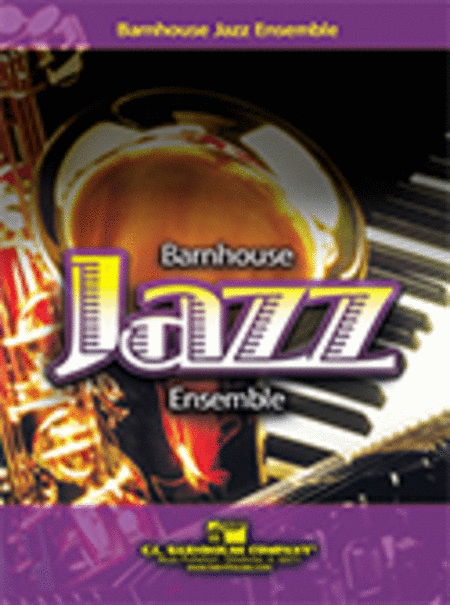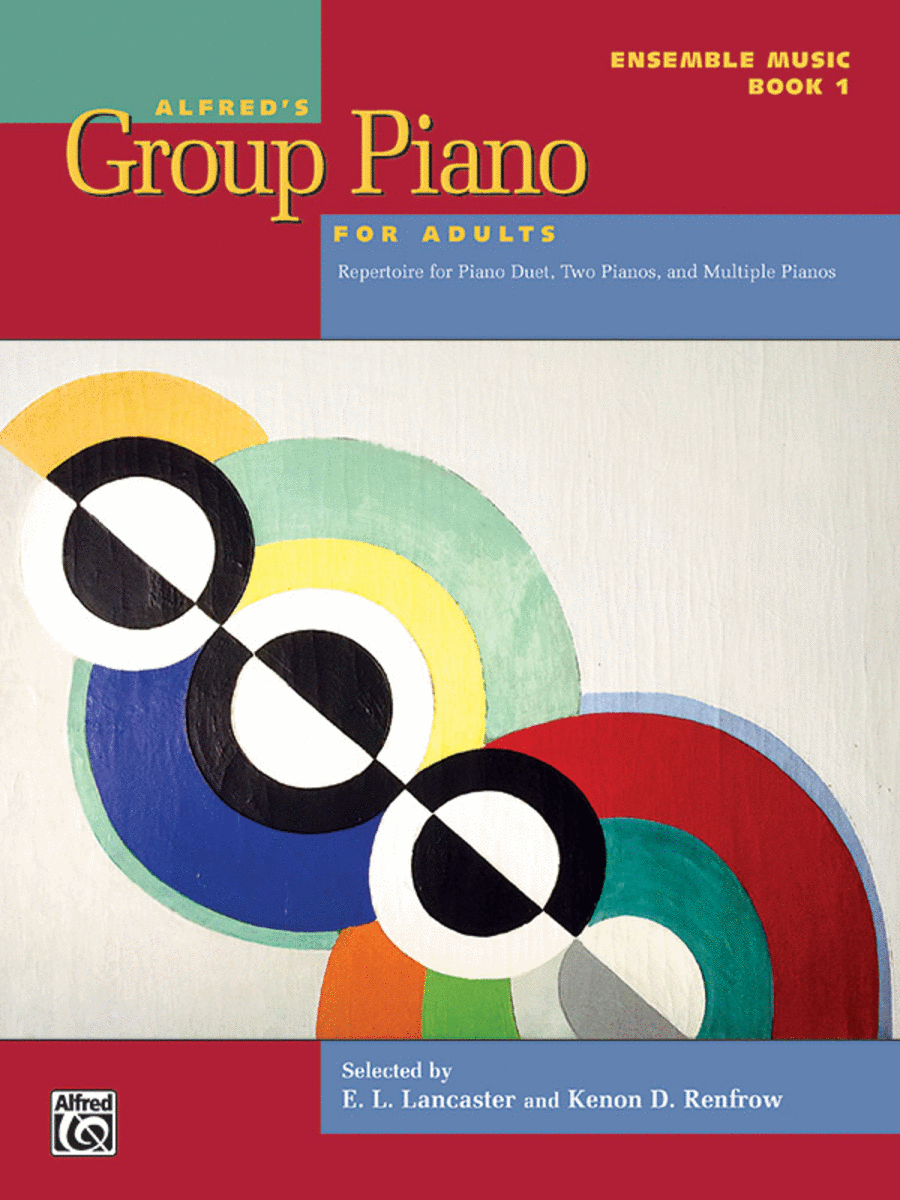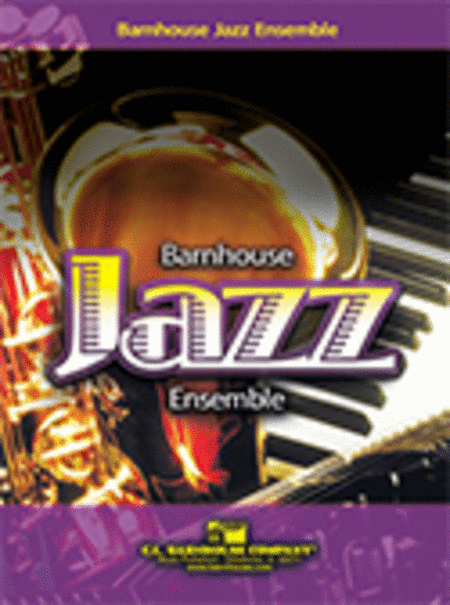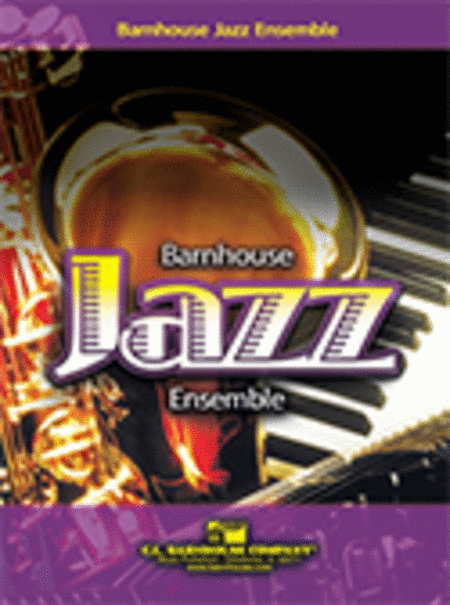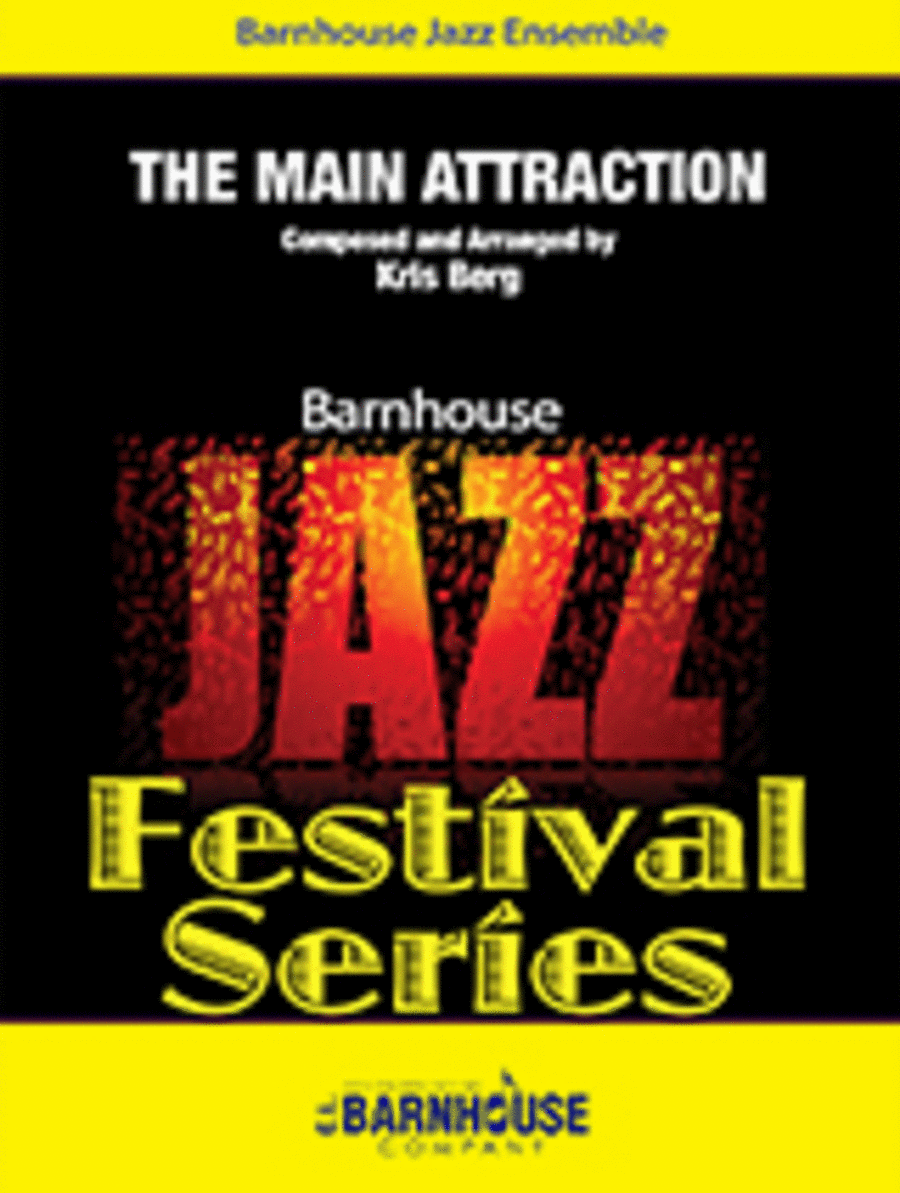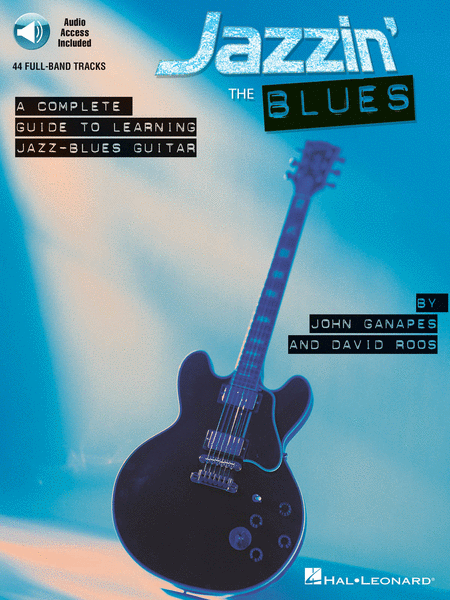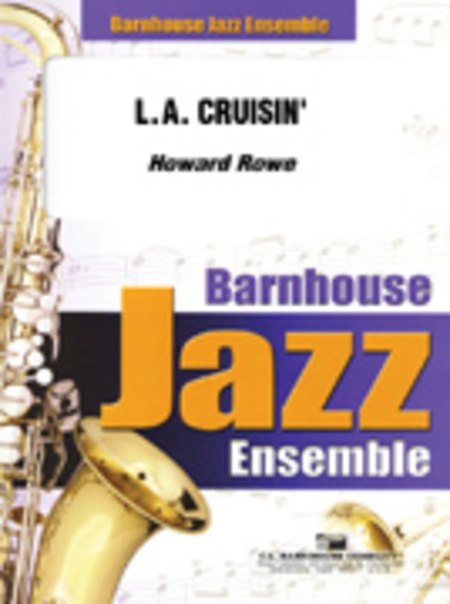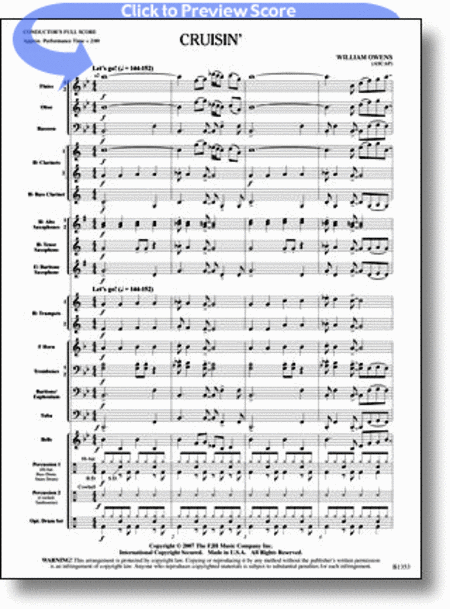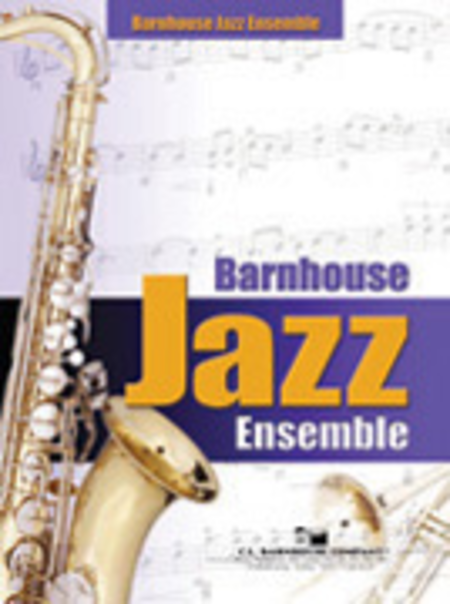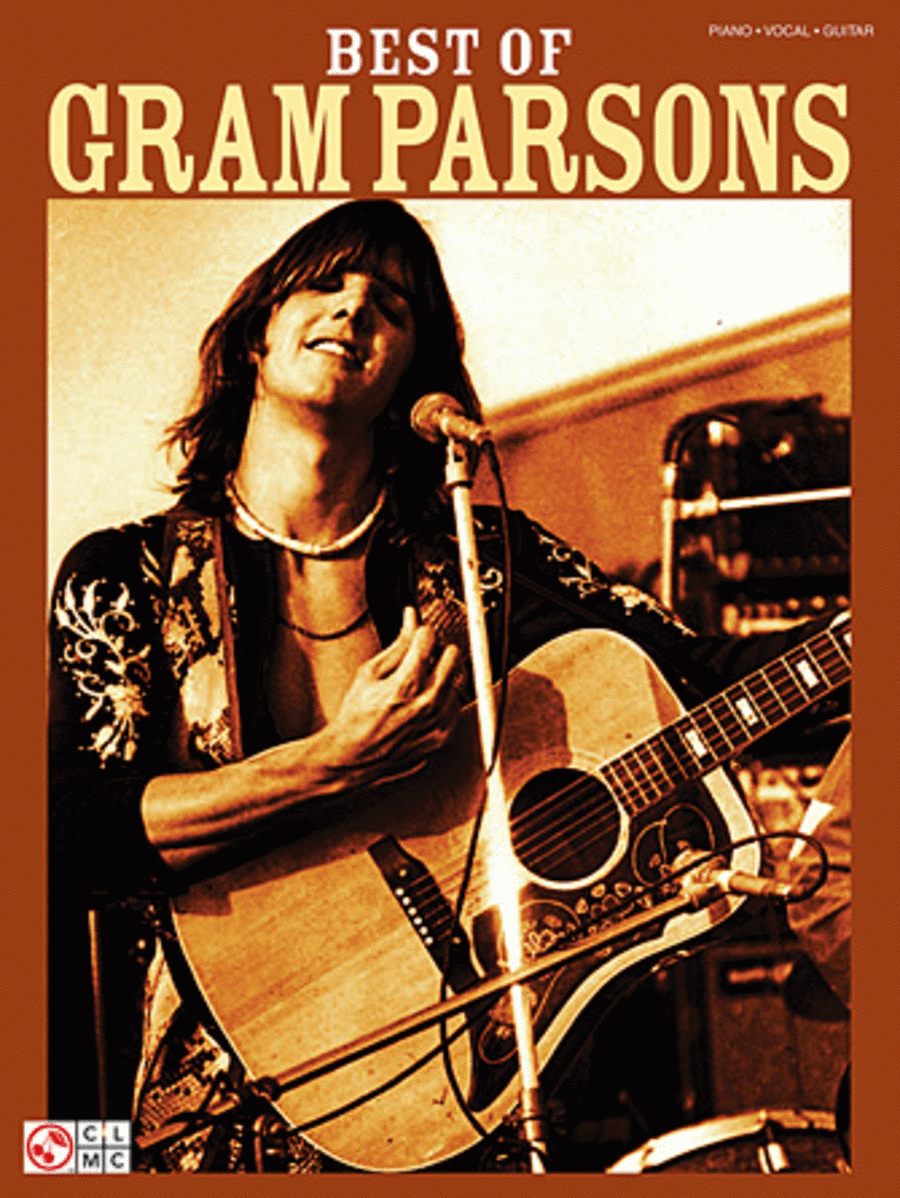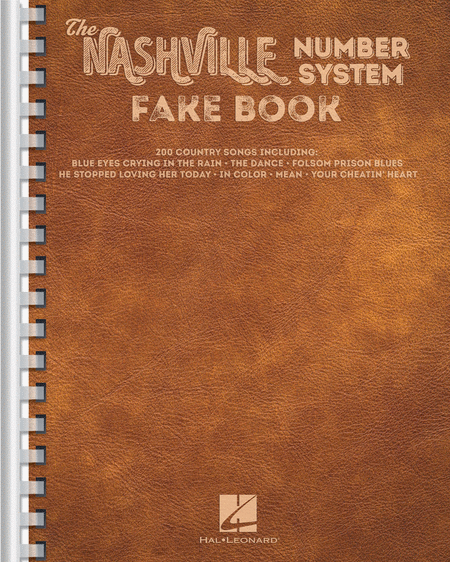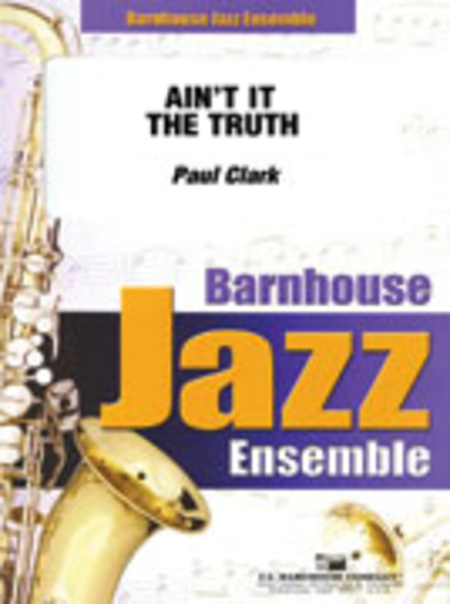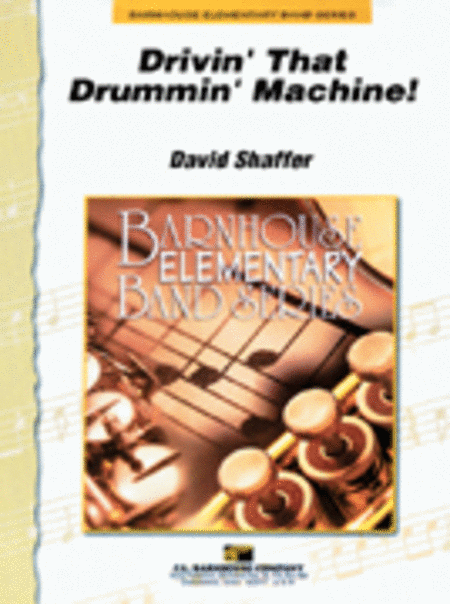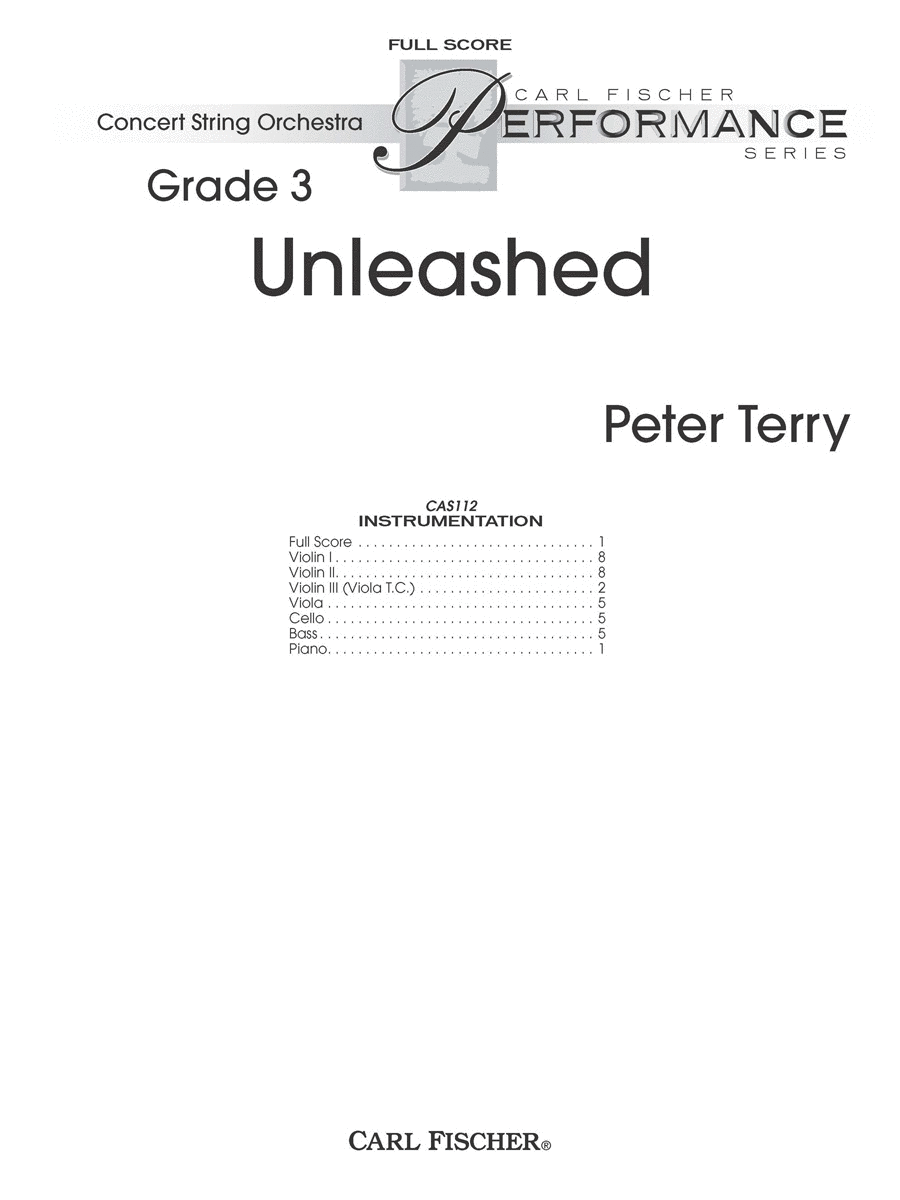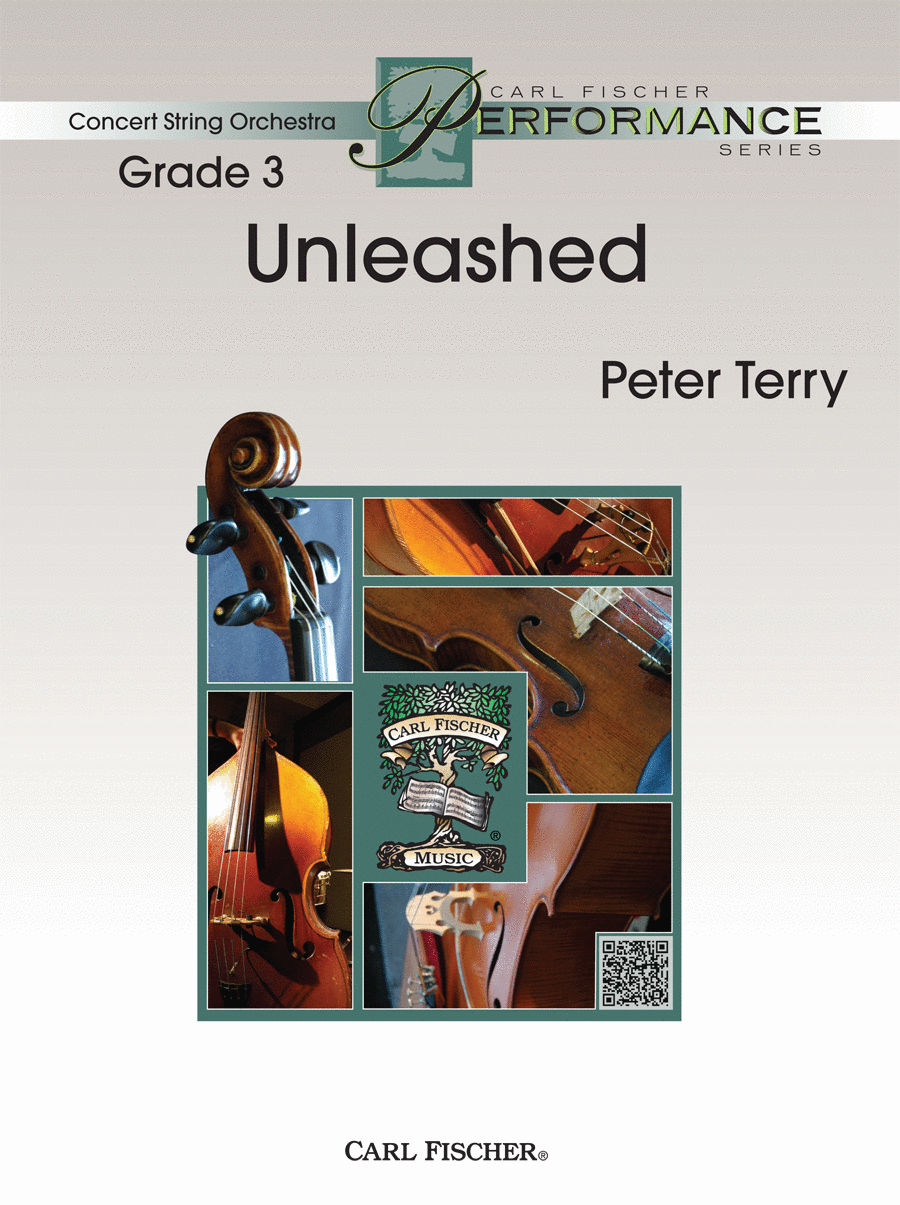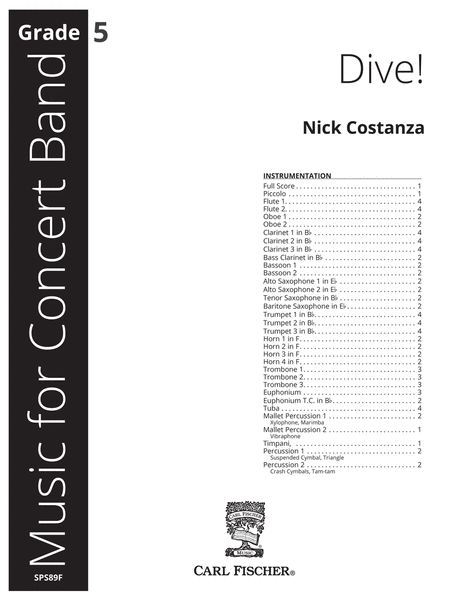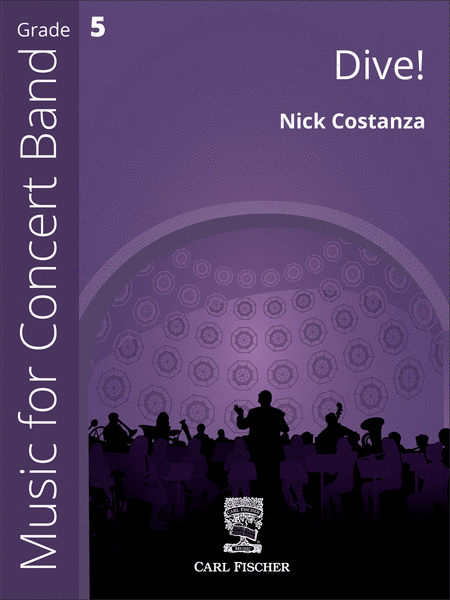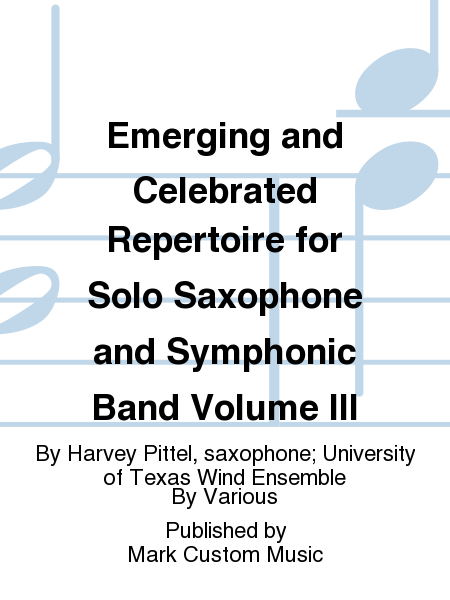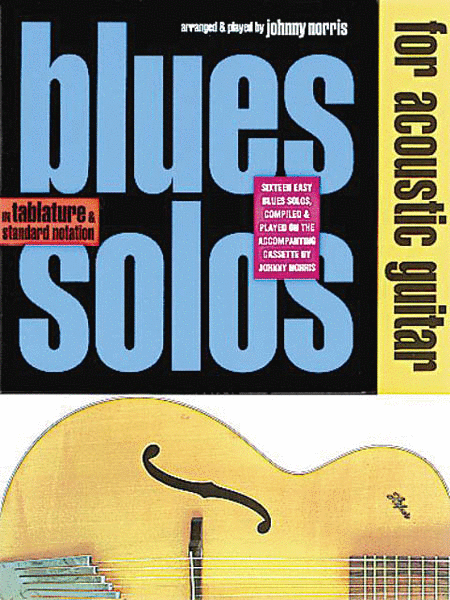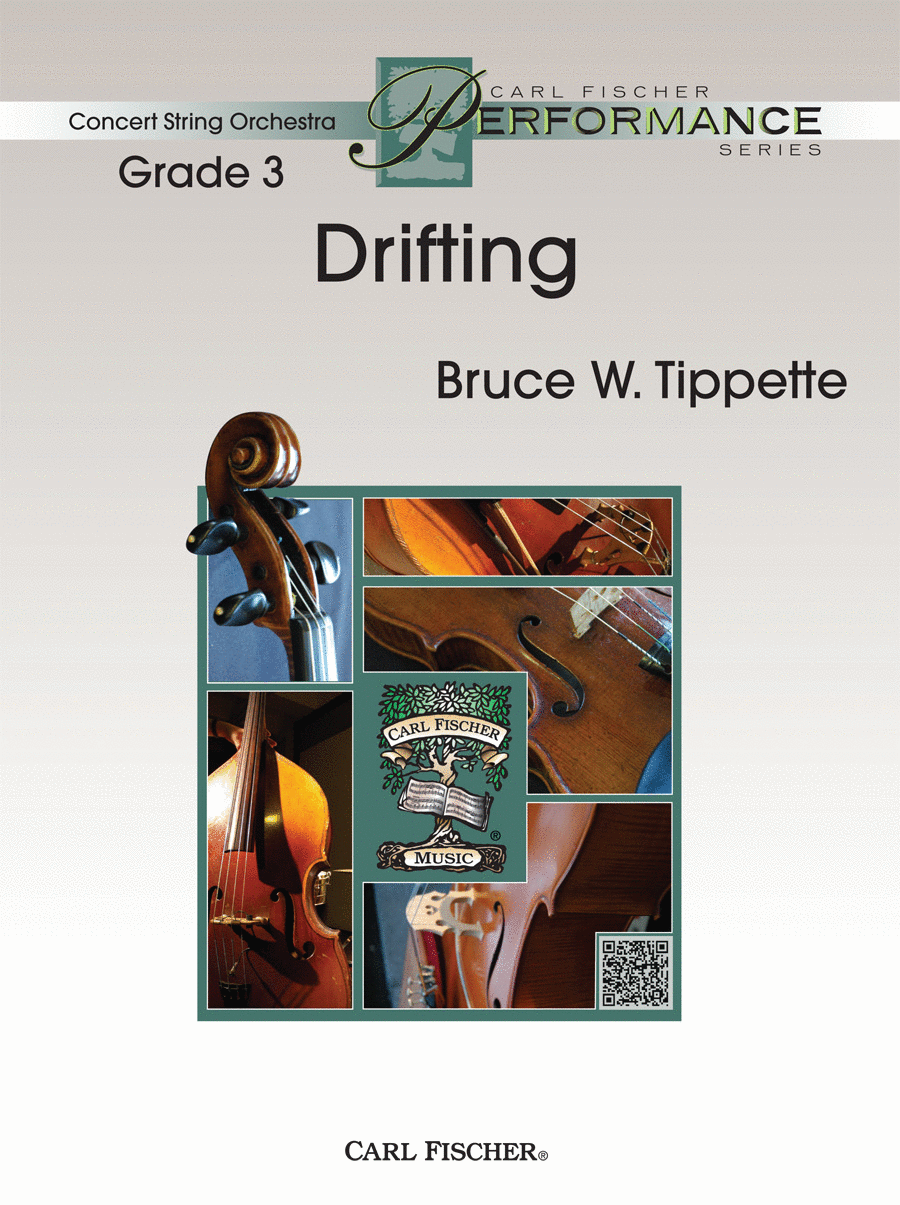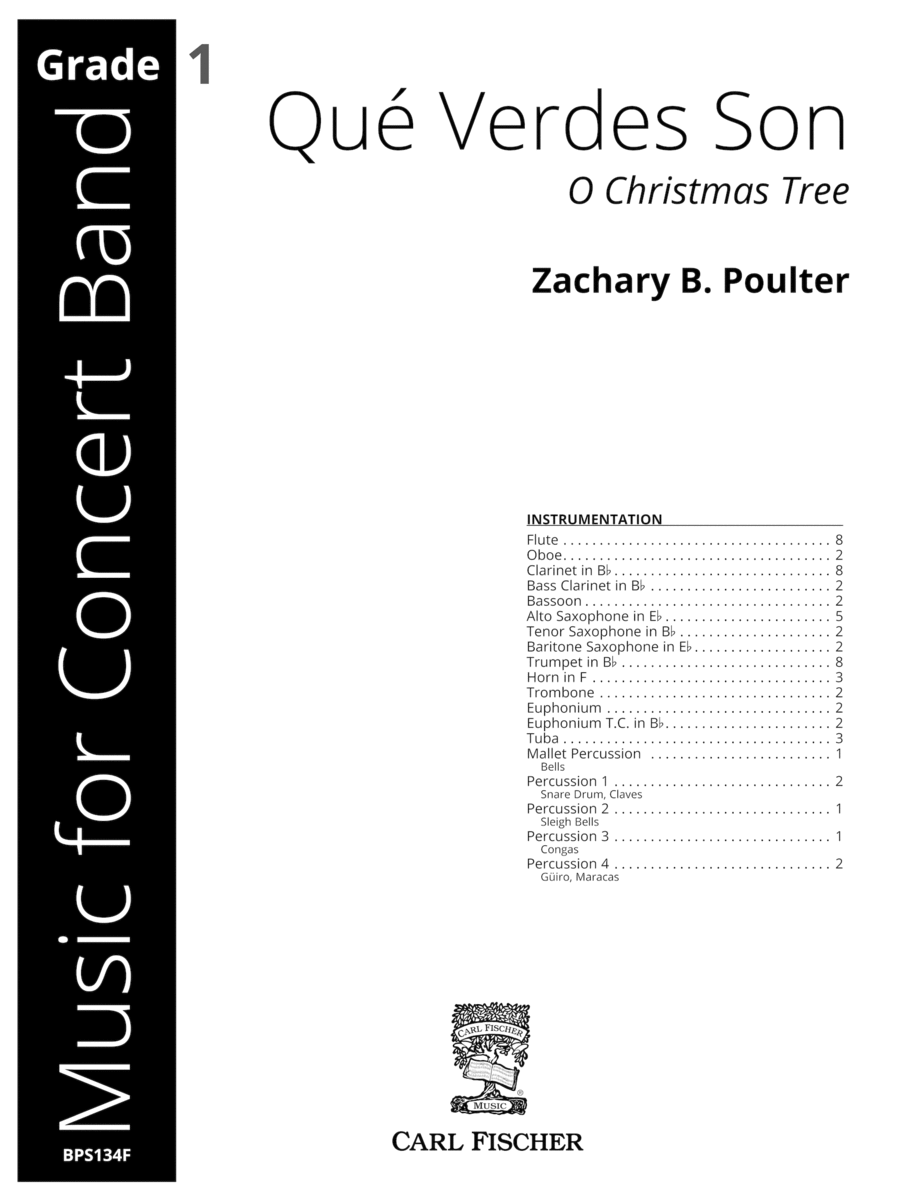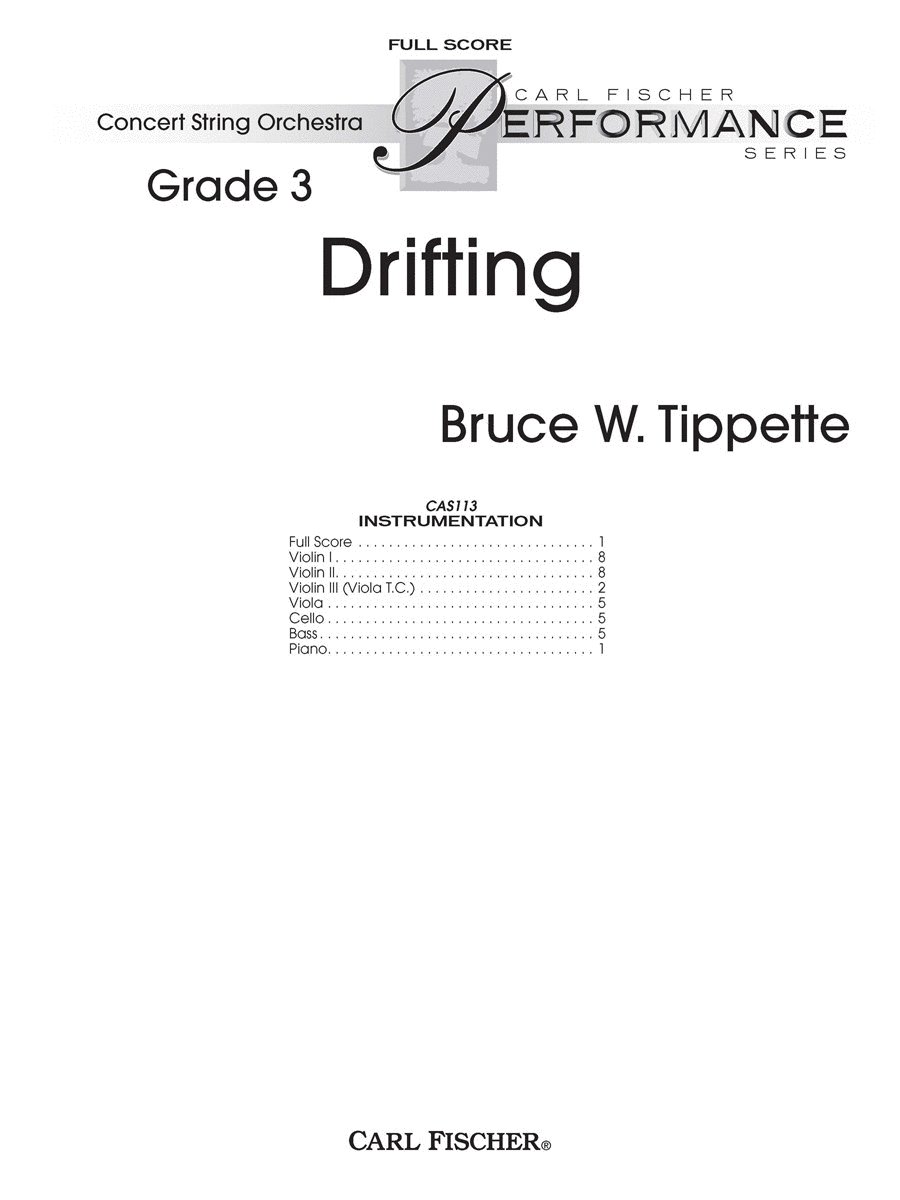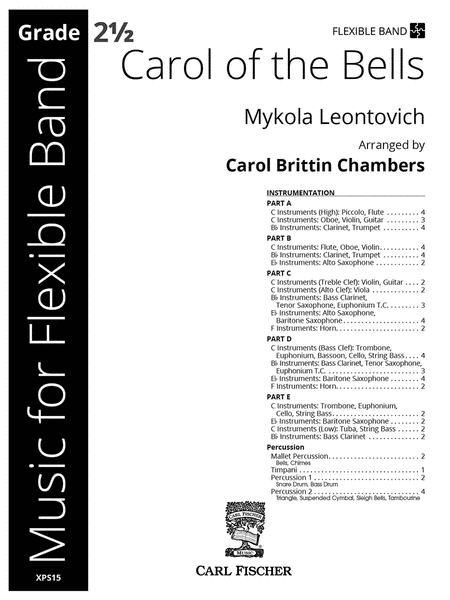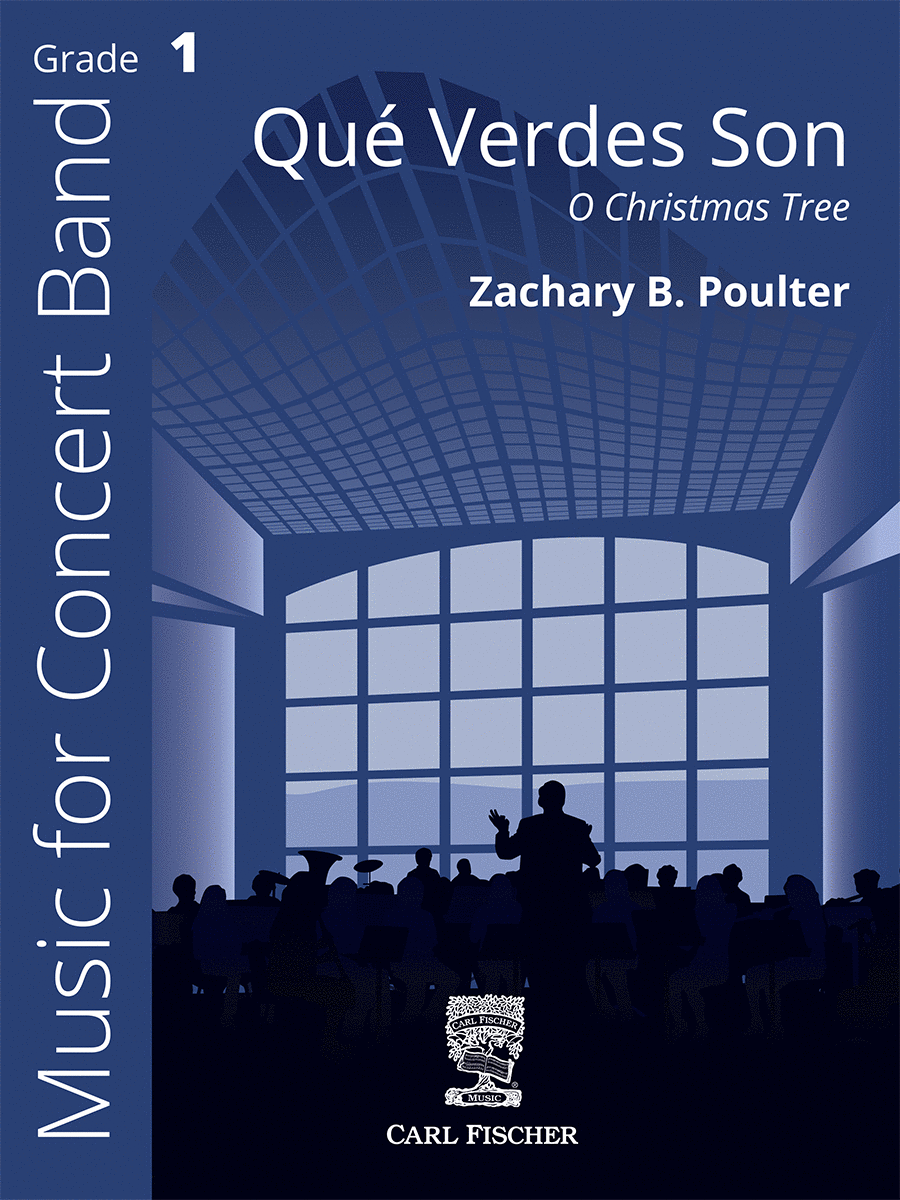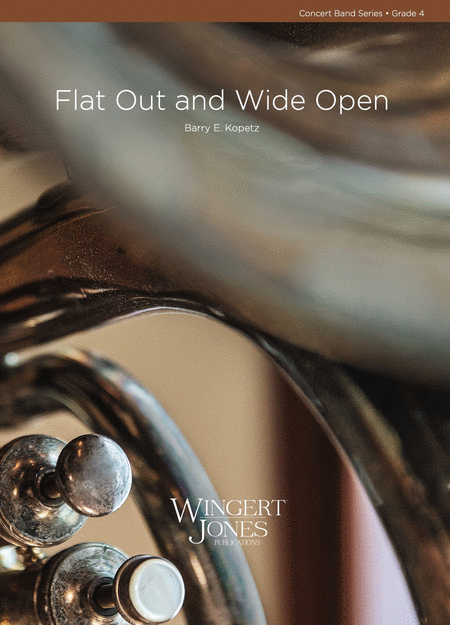|
| Steeplechase
Ensemble Jazz [Conducteur et Parties séparées] - Facile
C.L. Barnhouse
Grade 3 SKU: CL.032-2421-00 Jazz Ensemble. Score and set of parts. Compos...(+)
Grade 3 SKU:
CL.032-2421-00 Jazz
Ensemble. Score and set
of parts. Composed 1992.
C.L. Barnhouse
#032-2421-00. Published
by C.L. Barnhouse
(CL.032-2421-00).
An uptempo rock
original with a unique
sound, Steeplechase is
sure to catch the
imagination of your
students. Has solos for
tenor sax and trumpet
(written suggested solos
are provided) and lots of
hard drivin’ rock
for the whole ensemble.
Ranges are quite modest
for a chart at this level
and a great little fugue
section after the solos
helps make this a very
strong arrangement. $50.00 - Voir plus => AcheterDélais: 1 to 2 weeks | | | |
| No Scuffle Shuffle
Big band [Conducteur et Parties séparées]
Handelsware
Big band - intermediate to advanced SKU: M7.BARN-32247600 Shuffle....(+)
Big band - intermediate
to advanced SKU:
M7.BARN-32247600
Shuffle. Composed
by Dominic Spera. Sheet
music. Score and parts.
Duration 6'. Handelsware
#BARN 32247600. Published
by Handelsware
(M7.BARN-32247600).
English. A hot,
drivin' shuffle by
Dominic Spera that is
sure to be a big favorite
at festivals and concerts
everywhere. An extremely
bold introduction gets
things started on the
right foot and then it
just gets better and
better! Easily opened up
for as many solos as you
wish, this exciting chart
is a real showstopper for
a solid band. $82.95 - Voir plus => AcheterDélais: 4 to 6 weeks | | | |
| Alfred's Group Piano for Adults -- Ensemble Music
1 Piano, 4 mains - Débutant
Alfred Publishing
Repertoire for Piano Duet, Two Pianos, and Multiple Pianos. Composed by Select...(+)
Repertoire for Piano
Duet,
Two Pianos, and Multiple
Pianos. Composed by
Selected
by E. L. Lancaster and
Kenon
D. Renfrow.
Method/Instruction; Piano
-
Alfred's Group Piano for
Adults. Alfred's Group
Piano
for Adults. Book. 80
pages.
Alfred Music #00-47849.
Published by Alfred Music
$12.99 - Voir plus => AcheterDélais: 1 to 2 weeks | | | |
| Blues A-Z: A Beginner's Guide to Blues Style, Theory, and Improv
Piano seul - Intermédiaire
Hal Leonard
Educational Piano Library. Blues Instruction, Jazz Instruction. Softcover. 48 ...(+)
Educational Piano
Library.
Blues Instruction, Jazz
Instruction. Softcover.
48
pages. Published by Hal
Leonard
$16.99 - Voir plus => AcheterDélais: 24 hours - In Stock | | | |
| No Scuffle Shuffle [Conducteur] - Intermédiaire
C.L. Barnhouse
Grade 3.5 SKU: CL.032-2476-01 Composed by Spera. Jazz Ensemble. Audio rec...(+)
Grade 3.5 SKU:
CL.032-2476-01
Composed by Spera. Jazz
Ensemble. Audio recording
available separately
(items CL.WFR177 &
CL.991-2008-02). Extra
full score. Composed
1992. Duration 6 minutes,
26 seconds. C.L.
Barnhouse #032-2476-01.
Published by C.L.
Barnhouse
(CL.032-2476-01).
A hot,
drivin’ shuffle by
Dominic Spera that is
sure to be a big favorite
at festivals and concerts
everywhere. An extremely
bold introduction gets
things started on the
right foot and then it
just gets better and
better! Easily opened up
for as many solos as you
wish, this exciting chart
is a real showstopper for
a solid band. $8.00 - Voir plus => AcheterDélais: 1 to 2 weeks | | | |
| Some Juice for Bruce
Ensemble Jazz [Conducteur et Parties séparées] - Facile
C.L. Barnhouse
Grade 3 SKU: CL.032-2270-00 Composed by Rowe. Jazz Ensemble. Score and se...(+)
Grade 3 SKU:
CL.032-2270-00
Composed by Rowe. Jazz
Ensemble. Score and set
of parts. Composed 1990.
C.L. Barnhouse
#032-2270-00. Published
by C.L. Barnhouse
(CL.032-2270-00).
Hard
Drivin’ funk in
the Crusaders’
style. A great vehicle
for young soloists and
can be a super feature
for that one really
exceptional player in
your band! Playable with
reduced instrumentation.
Suggested solos
included. $50.00 - Voir plus => AcheterDélais: 1 to 2 weeks | | | |
| The Main Attraction
Ensemble Jazz [Conducteur] - Facile
C.L. Barnhouse
Grade 3 SKU: CL.032-4858-01 Composed by Berg. Jazz Ensemble. Extra full s...(+)
Grade 3 SKU:
CL.032-4858-01
Composed by Berg. Jazz
Ensemble. Extra full
score. C.L. Barnhouse
#032-4858-01. Published
by C.L. Barnhouse
(CL.032-4858-01).
The Main
Attraction is a hard
drivin’ shuffle in
the style of Basie, Thad
and Mel, and Phil Wilson,
but with a slightly more
modern groove. This is
the perfect opener for
any concert or festival!
The tune is based on a
16-bar blues, features
lots of ensemble for the
band, and has solo spots
for any saxophone, brass
player, guitarist or
pianist. Your performance
can’t go wrong if
you’re featuring
The Main Attraction!. $8.00 - Voir plus => AcheterDélais: 1 to 2 weeks | | | |
| Whammy Bar & Finger Grease (cd)
Music Sales
| | | |
| Jazzin' the Blues (Guitar)
Guitare notes et tablatures [Partition + Accès audio]
Hal Leonard
A Complete Guide to Learning Jazz-Blues Guitar. Guitar Educational. Book and CD ...(+)
A Complete Guide to
Learning Jazz-Blues
Guitar. Guitar
Educational. Book and CD
Package. With notes and
tablature. Size 9x12
inches. 104 pages.
Published by Hal Leonard.
(1)$22.99 - Voir plus => AcheterDélais: 24 hours - In Stock | | | |
| L. A. Cruisin' [Conducteur et Parties séparées] - Facile
C.L. Barnhouse
Grade 3 SKU: CL.032-3272-00 Composed by Rowe. Jazz Ensemble. Barnhouse Me...(+)
Grade 3 SKU:
CL.032-3272-00
Composed by Rowe. Jazz
Ensemble. Barnhouse
Medium Jazz Series. Audio
recording available
separately (items
CL.991-2003-01 &
CL.991-2003-02). Score
and set of parts.
Composed 2003. Duration 5
minutes, 4 seconds. C.L.
Barnhouse #032-3272-00.
Published by C.L.
Barnhouse
(CL.032-3272-00).
A hard drivin'
swing shuffle chart in
the Quincy Jones mode
that really cooks! Built
on an extended Blues
form, every section gets
a chance to shine and it
includes an open solo
section for the soloists
of your choosing (written
suggested solos are
included). Playable with
limited instrumentation
and a helpful Guitar
Performance Help Sheet is
included. Big sounding
ensemble sections make
this a great choice for
any occasion for
mid-level bands.
OUTSTANDING! $50.00 - Voir plus => AcheterDélais: 1 to 2 weeks | | | |
| Cruisin'
Orchestre d'harmonie [Conducteur et Parties séparées] - Facile
FJH
By William Owens. For concert band. FJH Young Band. Full set (score and parts). ...(+)
By William Owens. For
concert band. FJH Young
Band. Full set (score and
parts). Score only also
available: B1353S. Grade
2. Score and set of
parts. Composed 2007
$60.00 - Voir plus => AcheterDélais: 4 to 6 weeks | | | |
| Comin' At Ya!
Ensemble Jazz [Conducteur et Parties séparées] - Facile
C.L. Barnhouse
| | | |
| Best of Gram Parsons
Piano, Voix et Guitare [Partition]
Cherry Lane
By Gram Parsons. Piano/Vocal/Chords Songbook (Arrangements for piano and voice w...(+)
By Gram Parsons.
Piano/Vocal/Chords
Songbook (Arrangements
for piano and voice with
guitar chords). 70 pages.
Published by Cherry Lane
Music.
(2)$16.95 - Voir plus => AcheterDélais: 24 hours - In Stock | | | |
| The Nashville Number System Fake Book
Guitare [Fake Book]
Hal Leonard
By Various. Edited by Trevor de Clercq. Fake Book. Softcover. 224 pages. P...(+)
By Various. Edited by
Trevor
de Clercq. Fake Book.
Softcover. 224 pages.
Published by Hal Leonard
$34.99 - Voir plus => AcheterDélais: 24 hours - In Stock | | | |
| Ain't It the Truth
Ensemble Jazz [Conducteur et Parties séparées] - Intermédiaire
C.L. Barnhouse
By Paul Clark. Jazz Ensemble. Grade 3. Score and set of parts. Composed 2006. Du...(+)
By Paul Clark. Jazz
Ensemble. Grade 3. Score
and set of parts.
Composed 2006. Duration
0:03:10
$50.00 - Voir plus => AcheterDélais: 1 to 2 weeks | | | |
| Drivin' That Drummin' Machine!
Orchestre d'harmonie [Conducteur] - Débutant
C.L. Barnhouse
Grade 1 SKU: CL.015-3471-01 Composed by Shaffer. Young Concert Band. Elem...(+)
Grade 1 SKU:
CL.015-3471-01
Composed by Shaffer.
Young Concert Band.
Elementary Series. Audio
recording available
separately (items
CL.WFR336 & CL.WFR344).
Extra full score.
Composed 2005. Duration 2
minutes, 17 seconds. C.L.
Barnhouse #015-3471-01.
Published by C.L.
Barnhouse
(CL.015-3471-01).
A very easy but
solid rock tune that
features the whole drum
section. Full of fun and
vitality and a great way
to let your young
drummers shine! Horn
parts are powerful and
provide a great backing
for the percussion. Sure
to be a big hit at any
concert performance but
mostly, this one is just
a ton of fun!!!! $5.00 - Voir plus => AcheterDélais: 1 to 2 weeks | | | |
| Unleashed [Conducteur] - Facile
Carl Fischer
Orchestra Cello, Contrabass, Piano, Viola, Violin 1, Violin 2, Violin 3 - Grade ...(+)
Orchestra Cello,
Contrabass, Piano, Viola,
Violin 1, Violin 2,
Violin 3 - Grade 3
SKU: CF.CAS112F
Composed by Peter Terry.
Concert String Orchestra
(CAS). Full score. With
Standard notation. 12
pages. Carl Fischer Music
#CAS112F. Published by
Carl Fischer Music
(CF.CAS112F). ISBN
9781491151686. UPC:
680160909186. 9 x 12
inches. Peter
Terry's Unleashed?makes
for an impressive concert
opener that is the
musical equivalent of
unleashing a caged
animal. The piece is
exciting from start to
finish, with energetic
and bold material that
students will love to
play.
Everyone wants
to be unleashed, to be
set free of restraints.
This piece captures the
exhilaration of being set
into motion with
unlimited optimism and
energy. The piece is a
rhythmic and
propulsive gallop that spins
off lyrical material as
it drives to a climactic
finish that is both
exciting and
fun. The piece opens
with a robust
first theme, then
transitions on a rhythmic
figure spun off from the
opening
material. The opening
section
repeats in
variation with different
orchestration. The more
lyrical material that
emerges should be brought
out to balance the first
theme and rhythmic
figures from the first
section. A development of
the material from the
opening follows,
driving to a
brief
pause. This
pause
feels like it
will lead to a
contrasting lyrical
theme, but the energy
is
just suspended for a
second before the piece
takes off again.
The
work finishes with a
repeated-note transition
back to variations on the
opening material and a
propulsive rush to the
end. I enjoyed
writing this piece and
hope your students will
enjoy playing these
contrasting styles and
that you will find the
piece beneficial in
teaching important
musical concepts.
?????????Peter Terry,
2018.
Everyone
wants to be unleashed, to
be set free of
restraints. This piece
captures the exhilaration
of being set into motion
with unlimited optimism
and energy.A The piece is a
rhythmic and
propulsive gallop that spins
off lyrical material as
it drives to a climactic
finish that is both
exciting and
fun. The piece opens
with a robust
first theme, then
transitions on a rhythmic
figure spun off from the
opening
material. The opening
section
repeats in
variation with different
orchestration. The more
lyrical material that
emerges should be brought
out to balance the first
theme and rhythmic
figures from the first
section. A development of
the material from the
opening follows,
driving to a
brief
pause. This
pause
feels like it
will lead to a
contrasting lyrical
theme, but the energy
is
just suspended for a
second before the piece
takes off again.
The
work finishes with a
repeated-note transition
back to variations on the
opening material and a
propulsive rush to the
end. I enjoyed
writing this piece and
hope your students will
enjoy playing these
contrasting styles and
that you will find the
piece beneficial in
teaching important
musical concepts.
?????????Peter Terry,
2018.
Everyone
wants to be unleashed, to
be set free of
restraints. This piece
captures the exhilaration
of being set into motion
with unlimited optimism
and energy.A The piece is a
rhythmic and
propulsive gallop that spins
off lyrical material as
it drives to a climactic
finish that is both
exciting and
fun. The piece opens
with a robust
first theme, then
transitions on a rhythmic
figure spun off from the
opening
material. The opening
section
repeats in
variation with different
orchestration. The more
lyrical material that
emerges should be brought
out to balance the first
theme and rhythmic
figures from the first
section. A development of
the material from the
opening follows,
driving to a
brief
pause. This
pause
feels like it
will lead to a
contrasting lyrical
theme, but the energy
is
just suspended for a
second before the piece
takes off again.
The
work finishes with a
repeated-note transition
back to variations on the
opening material and a
propulsive rush to the
end. I enjoyed
writing this piece and
hope your students will
enjoy playing these
contrasting styles and
that you will find the
piece beneficial in
teaching important
musical concepts.
?????????Peter Terry,
2018.
Everyone
wants to be unleashed, to
be set free of
restraints. This piece
captures the exhilaration
of being set into motion
with unlimited optimism
and energy. The piece is a
rhythmic and
propulsive gallop that spins
off lyrical material as
it drives to a climactic
finish that is both
exciting and
fun. The piece opens
with a robust
first theme, then
transitions on a rhythmic
figure spun off from the
opening
material. The opening
section
repeats in
variation with different
orchestration. The more
lyrical material that
emerges should be brought
out to balance the first
theme and rhythmic
figures from the first
section. A development of
the material from the
opening follows,
driving to a
brief
pause. This
pause
feels like it
will lead to a
contrasting lyrical
theme, but the energy
is
just suspended for a
second before the piece
takes off again.
The
work finishes with a
repeated-note transition
back to variations on the
opening material and a
propulsive rush to the
end. I enjoyed
writing this piece and
hope your students will
enjoy playing these
contrasting styles and
that you will find the
piece beneficial in
teaching important
musical concepts.
?????????Peter Terry,
2018.
Eve
ryone wants to be
unleashed, to be set free
of restraints. This piece
captures the exhilaration
of being set into motion
with unlimited optimism
and energy. The piece is
a rhythmic and propulsive
gallop that spins off
lyrical material as it
drives to a climactic
finish that is both
exciting and fun. The
piece opens with a robust
first theme, then
transitions on a rhythmic
figure spun off from the
opening material. The
opening section repeats
in variation with
different orchestration.
The more lyrical material
that emerges should be
brought out to balance
the first theme and
rhythmic figures from the
first section. A
development of the
material from the opening
follows, driving to a
brief pause. This pause
feels like it will lead
to a contrasting lyrical
theme, but the energy is
just suspended for a
second before the piece
takes off again. The work
finishes with a
repeated-note transition
back to variations on the
opening material and a
propulsive rush to the
end. I enjoyed writing
this piece and hope your
students will enjoy
playing these contrasting
styles and that you will
find the piece beneficial
in teaching important
musical concepts. Peter
Terry, 2018.
Everyone
wants to be unleashed, to
be set free of
restraints. This piece
captures the exhilaration
of being set into motion
with unlimited optimism
and energy. The piece
is a rhythmic and
propulsive gallop that
spins off lyrical
material as it drives to
a climactic finish that
is both exciting and
fun.The piece opens with
a robust first theme,
then transitions on a
rhythmic figure spun off
from the opening
material. The opening
section repeats in
variation with different
orchestration. The more
lyrical material that
emerges should be brought
out to balance the first
theme and rhythmic
figures from the first
section. A development of
the material from the
opening follows, driving
to a brief pause. This
pause feels like it will
lead to a contrasting
lyrical theme, but the
energy is just suspended
for a second before the
piece takes off again.
The work finishes with a
repeated-note transition
back to variations on the
opening material and a
propulsive rush to the
end.I enjoyed writing
this piece and hope your
students will enjoy
playing these contrasting
styles and that you will
find the piece beneficial
in teaching important
musical
concepts.​​
​​​Ã
¢â‚¬â€¹Ã¢â‚¬â€¹Ã¢â‚¬â€¹Ã¢
€‹Peter Terry,
2018.
About Carl
Fischer Concert String
Orchestra
Series Thi
s series of pieces (Grade
3 and higher) is designed
for advancing ensembles.
The pieces in this series
are characterized
by: - Expanded use
of rhythms, ranges and
keys but technical
demands are still
carefully
considered
- More
comprehensive bowing
techniques
- Viola
T.C.
included
- Careful
selection of keys and
degree of difficulty for
advancing
musicians
$9.50 - Voir plus => AcheterDélais: 1 to 2 weeks | | | |
| Unleashed - Facile
Carl Fischer
Orchestra Cello, Contrabass, Piano, Viola, Violin 1, Violin 2, Violin 3 - Grade ...(+)
Orchestra Cello,
Contrabass, Piano, Viola,
Violin 1, Violin 2,
Violin 3 - Grade 3
SKU: CF.CAS112
Composed by Peter Terry.
Concert String Orchestra
(CAS). Set of Score and
Parts. With Standard
notation.
16+4+16+10+10+10+4+12
pages. Duration 2
minutes, 57 seconds. Carl
Fischer Music #CAS112.
Published by Carl Fischer
Music (CF.CAS112).
ISBN 9781491151310.
UPC: 680160908813. 9 x 12
inches. Key: E
minor. Peter
Terry's Unleashed?makes
for an impressive concert
opener that is the
musical equivalent of
unleashing a caged
animal. The piece is
exciting from start to
finish, with energetic
and bold material that
students will love to
play.
Everyone wants
to be unleashed, to be
set free of restraints.
This piece captures the
exhilaration of being set
into motion with
unlimited optimism and
energy. The piece is a
rhythmic and
propulsive gallop that spins
off lyrical material as
it drives to a climactic
finish that is both
exciting and
fun. The piece opens
with a robust
first theme, then
transitions on a rhythmic
figure spun off from the
opening
material. The opening
section
repeats in
variation with different
orchestration. The more
lyrical material that
emerges should be brought
out to balance the first
theme and rhythmic
figures from the first
section. A development of
the material from the
opening follows,
driving to a
brief
pause. This
pause
feels like it
will lead to a
contrasting lyrical
theme, but the energy
is
just suspended for a
second before the piece
takes off again.
The
work finishes with a
repeated-note transition
back to variations on the
opening material and a
propulsive rush to the
end. I enjoyed
writing this piece and
hope your students will
enjoy playing these
contrasting styles and
that you will find the
piece beneficial in
teaching important
musical concepts.
?????????Peter Terry,
2018.
Everyone
wants to be unleashed, to
be set free of
restraints. This piece
captures the exhilaration
of being set into motion
with unlimited optimism
and energy.A The piece is a
rhythmic and
propulsive gallop that spins
off lyrical material as
it drives to a climactic
finish that is both
exciting and
fun. The piece opens
with a robust
first theme, then
transitions on a rhythmic
figure spun off from the
opening
material. The opening
section
repeats in
variation with different
orchestration. The more
lyrical material that
emerges should be brought
out to balance the first
theme and rhythmic
figures from the first
section. A development of
the material from the
opening follows,
driving to a
brief
pause. This
pause
feels like it
will lead to a
contrasting lyrical
theme, but the energy
is
just suspended for a
second before the piece
takes off again.
The
work finishes with a
repeated-note transition
back to variations on the
opening material and a
propulsive rush to the
end. I enjoyed
writing this piece and
hope your students will
enjoy playing these
contrasting styles and
that you will find the
piece beneficial in
teaching important
musical concepts.
?????????Peter Terry,
2018.
Everyone
wants to be unleashed, to
be set free of
restraints. This piece
captures the exhilaration
of being set into motion
with unlimited optimism
and energy.A The piece is a
rhythmic and
propulsive gallop that spins
off lyrical material as
it drives to a climactic
finish that is both
exciting and
fun. The piece opens
with a robust
first theme, then
transitions on a rhythmic
figure spun off from the
opening
material. The opening
section
repeats in
variation with different
orchestration. The more
lyrical material that
emerges should be brought
out to balance the first
theme and rhythmic
figures from the first
section. A development of
the material from the
opening follows,
driving to a
brief
pause. This
pause
feels like it
will lead to a
contrasting lyrical
theme, but the energy
is
just suspended for a
second before the piece
takes off again.
The
work finishes with a
repeated-note transition
back to variations on the
opening material and a
propulsive rush to the
end. I enjoyed
writing this piece and
hope your students will
enjoy playing these
contrasting styles and
that you will find the
piece beneficial in
teaching important
musical concepts.
?????????Peter Terry,
2018.
Everyone
wants to be unleashed, to
be set free of
restraints. This piece
captures the exhilaration
of being set into motion
with unlimited optimism
and energy. The piece is a
rhythmic and
propulsive gallop that spins
off lyrical material as
it drives to a climactic
finish that is both
exciting and
fun. The piece opens
with a robust
first theme, then
transitions on a rhythmic
figure spun off from the
opening
material. The opening
section
repeats in
variation with different
orchestration. The more
lyrical material that
emerges should be brought
out to balance the first
theme and rhythmic
figures from the first
section. A development of
the material from the
opening follows,
driving to a
brief
pause. This
pause
feels like it
will lead to a
contrasting lyrical
theme, but the energy
is
just suspended for a
second before the piece
takes off again.
The
work finishes with a
repeated-note transition
back to variations on the
opening material and a
propulsive rush to the
end. I enjoyed
writing this piece and
hope your students will
enjoy playing these
contrasting styles and
that you will find the
piece beneficial in
teaching important
musical concepts.
?????????Peter Terry,
2018.
Eve
ryone wants to be
unleashed, to be set free
of restraints. This piece
captures the exhilaration
of being set into motion
with unlimited optimism
and energy. The piece is
a rhythmic and propulsive
gallop that spins off
lyrical material as it
drives to a climactic
finish that is both
exciting and fun. The
piece opens with a robust
first theme, then
transitions on a rhythmic
figure spun off from the
opening material. The
opening section repeats
in variation with
different orchestration.
The more lyrical material
that emerges should be
brought out to balance
the first theme and
rhythmic figures from the
first section. A
development of the
material from the opening
follows, driving to a
brief pause. This pause
feels like it will lead
to a contrasting lyrical
theme, but the energy is
just suspended for a
second before the piece
takes off again. The work
finishes with a
repeated-note transition
back to variations on the
opening material and a
propulsive rush to the
end. I enjoyed writing
this piece and hope your
students will enjoy
playing these contrasting
styles and that you will
find the piece beneficial
in teaching important
musical concepts. Peter
Terry, 2018.
Everyone
wants to be unleashed, to
be set free of
restraints. This piece
captures the exhilaration
of being set into motion
with unlimited optimism
and energy. The piece
is a rhythmic and
propulsive gallop that
spins off lyrical
material as it drives to
a climactic finish that
is both exciting and
fun.The piece opens with
a robust first theme,
then transitions on a
rhythmic figure spun off
from the opening
material. The opening
section repeats in
variation with different
orchestration. The more
lyrical material that
emerges should be brought
out to balance the first
theme and rhythmic
figures from the first
section. A development of
the material from the
opening follows, driving
to a brief pause. This
pause feels like it will
lead to a contrasting
lyrical theme, but the
energy is just suspended
for a second before the
piece takes off again.
The work finishes with a
repeated-note transition
back to variations on the
opening material and a
propulsive rush to the
end.I enjoyed writing
this piece and hope your
students will enjoy
playing these contrasting
styles and that you will
find the piece beneficial
in teaching important
musical
concepts.​​
​​​Ã
¢â‚¬â€¹Ã¢â‚¬â€¹Ã¢â‚¬â€¹Ã¢
€‹Peter Terry,
2018.
About Carl
Fischer Concert String
Orchestra
Series Thi
s series of pieces (Grade
3 and higher) is designed
for advancing ensembles.
The pieces in this series
are characterized
by: - Expanded use
of rhythms, ranges and
keys but technical
demands are still
carefully
considered
- More
comprehensive bowing
techniques
- Viola
T.C.
included
- Careful
selection of keys and
degree of difficulty for
advancing
musicians
$60.00 - Voir plus => AcheterDélais: 24 hours - In Stock | | | |
| Dive! [Conducteur] - Intermédiaire
Carl Fischer
Band Bass Clarinet, Bassoon 1, Bassoon 2, Clarinet 1, Clarinet 2, Clarinet 3, Cr...(+)
Band Bass Clarinet,
Bassoon 1, Bassoon 2,
Clarinet 1, Clarinet 2,
Clarinet 3, Crash
Cymbals, Euphonium,
Euphonium T.C., Flute 1,
Flute 2, Horn 1, Horn 2,
Horn 3, Horn 4, Mallet
Percussion 1, Mallet
Percussion 2, Oboe 1,
Oboe 2, Percussion 1 and
more. - Grade 5 SKU:
CF.SPS89F Composed by
Nicholas Costanza. Sws.
Sps. Full score. 32
pages. Duration 3
minutes, 52 seconds. Carl
Fischer Music #SPS89F.
Published by Carl Fischer
Music (CF.SPS89F).
ISBN 9781491156490.
UPC: 680160915033. 9 x 12
inches. Program
Notes This composition
for wind ensemble is
partially inspired by my
home town of Sebastian,
specifically its location
on the east coast of the
state of Florida. My
childhood included many
quick trips to both the
nearby Indian River and
the beaches on the coast,
so swimming and the water
were integral parts of my
experience growing up.
This work is my musical
expression of diving
underwater and getting
swept up by a fast
current and discovering
wonders beneath the
surface. Dive! has two
central components: a
constant, driving
eighth-note pulse and a
main theme which is
fragmented and passed
around at first, but then
is presented completely
by the low reeds around a
minute and a half into
the piece. The steady
eighth-note pulse
reflects the swift
current that a diver
might follow, while the
main theme represents all
the wonders that might be
hidden under the water.
Performance Notes
Ideally, the Trombone 3
part should be played on
a Bass Trombone. However,
if one is not available
there are cues for notes
that are beneath a tenor
trombone's range. Make
sure the vibraphone is
heard clearly throughout
the piece, as this
particular sound is very
important to the overall
color of this piece. The
Percussion 5 part
requires two performers
as some of the hits
happen too quickly for
one player to switch
between instruments. The
most important component
of this work is the
steady eighth-note pulse,
and this pulse never
changes even though the
meter changes frequently
to odd or uncommon time
signatures; if the eighth
notes remain constant and
driving, the meter
changes will not pose
much of a problem.
.
Program
NotesThis composition for
wind ensemble is
partially inspired by my
home town of Sebastian,
specifically its location
on the east coast of the
state of Florida. My
childhood included many
quick trips to both the
nearby Indian River and
the beaches on the coast,
so swimming and the water
were integral parts of my
experience growing up.
This work is my musical
expression of diving
underwater and getting
swept up by a fast
current and discovering
wonders beneath the
surface.Dive! has two
central components: a
constant, driving
eighth-note pulse and a
main theme which is
fragmented and passed
around at first, but then
is presented completely
by the low reeds around a
minute and a half into
the piece. The steady
eighth-note pulse
reflects the swift
current that a diver
might follow, while the
main theme represents all
the wonders that might be
hidden under the
water.Performance
NotesIdeally, the
Trombone 3 part should be
played on a Bass
Trombone. However, if one
is not available there
are cues for notes that
are beneath a tenor
trombone's range.Make
sure the vibraphone is
heard clearly throughout
the piece, as this
particular sound is very
important to the overall
color of this piece. The
Percussion 5 part
requires two performers
as some of the hits
happen too quickly for
one player to switch
between instruments.The
most important component
of this work is the
steady eighth-note pulse,
and this pulse never
changes even though the
meter changes frequently
to odd or uncommon time
signatures; if the eighth
notes remain constant and
driving, the meter
changes will not pose
much of a
problem.    Ã
‚ Â Â . $14.00 - Voir plus => AcheterDélais: 1 to 2 weeks | | | |
| Dive! - Intermédiaire
Carl Fischer
Band Bass Clarinet, Bassoon 1, Bassoon 2, Clarinet 1, Clarinet 2, Clarinet 3, Eu...(+)
Band Bass Clarinet,
Bassoon 1, Bassoon 2,
Clarinet 1, Clarinet 2,
Clarinet 3, Euphonium,
Euphonium T.C., Flute 1,
Flute 2, Horn 1, Horn 2,
Horn 3, Horn 4, Mallet
Percussion 1, Mallet
Percussion 2, Oboe 1,
Oboe 2, Percussion 1,
Percussion 2, Piccolo and
more. - Grade 5 SKU:
CF.SPS89 Composed by
Nicholas Costanza. Folio.
Sps. Set of Score and
Parts.
2+8+8+4+4+8+8+8+4+4+4+4+4
+4+4+8+8+8+4+4+4+4+6+6+6+
6+4+8+4+2+1+2+2+32 pages.
Duration 3 minutes, 52
seconds. Carl Fischer
Music #SPS89. Published
by Carl Fischer Music
(CF.SPS89). ISBN
9781491156483. UPC:
680160915026. 9 x 12
inches. Program
Notes This composition
for wind ensemble is
partially inspired by my
home town of Sebastian,
specifically its location
on the east coast of the
state of Florida. My
childhood included many
quick trips to both the
nearby Indian River and
the beaches on the coast,
so swimming and the water
were integral parts of my
experience growing up.
This work is my musical
expression of diving
underwater and getting
swept up by a fast
current and discovering
wonders beneath the
surface. Dive! has two
central components: a
constant, driving
eighth-note pulse and a
main theme which is
fragmented and passed
around at first, but then
is presented completely
by the low reeds around a
minute and a half into
the piece. The steady
eighth-note pulse
reflects the swift
current that a diver
might follow, while the
main theme represents all
the wonders that might be
hidden under the water.
Performance Notes
Ideally, the Trombone 3
part should be played on
a Bass Trombone. However,
if one is not available
there are cues for notes
that are beneath a tenor
trombone's range. Make
sure the vibraphone is
heard clearly throughout
the piece, as this
particular sound is very
important to the overall
color of this piece. The
Percussion 5 part
requires two performers
as some of the hits
happen too quickly for
one player to switch
between instruments. The
most important component
of this work is the
steady eighth-note pulse,
and this pulse never
changes even though the
meter changes frequently
to odd or uncommon time
signatures; if the eighth
notes remain constant and
driving, the meter
changes will not pose
much of a problem.
.
Program
NotesThis composition for
wind ensemble is
partially inspired by my
home town of Sebastian,
specifically its location
on the east coast of the
state of Florida. My
childhood included many
quick trips to both the
nearby Indian River and
the beaches on the coast,
so swimming and the water
were integral parts of my
experience growing up.
This work is my musical
expression of diving
underwater and getting
swept up by a fast
current and discovering
wonders beneath the
surface.Dive! has two
central components: a
constant, driving
eighth-note pulse and a
main theme which is
fragmented and passed
around at first, but then
is presented completely
by the low reeds around a
minute and a half into
the piece. The steady
eighth-note pulse
reflects the swift
current that a diver
might follow, while the
main theme represents all
the wonders that might be
hidden under the
water.Performance
NotesIdeally, the
Trombone 3 part should be
played on a Bass
Trombone. However, if one
is not available there
are cues for notes that
are beneath a tenor
trombone's range.Make
sure the vibraphone is
heard clearly throughout
the piece, as this
particular sound is very
important to the overall
color of this piece. The
Percussion 5 part
requires two performers
as some of the hits
happen too quickly for
one player to switch
between instruments.The
most important component
of this work is the
steady eighth-note pulse,
and this pulse never
changes even though the
meter changes frequently
to odd or uncommon time
signatures; if the eighth
notes remain constant and
driving, the meter
changes will not pose
much of a
problem.    Ã
‚ Â Â . $125.00 - Voir plus => AcheterDélais: 24 hours - In Stock | | | |
| Emerging and Celebrated Repertoire for Solo Saxophone and Symphonic Band Volume III
Saxophone [CD d'écoute]
Mark Custom Music
By Harvey Pittel With The University of Texas Wind Ensemble. For wind ensemble. ...(+)
By Harvey Pittel With The
University of Texas Wind
Ensemble. For wind
ensemble. Classical.
Performance CD
$14.99 - Voir plus => AcheterDélais: 4 to 6 weeks | | | |
| Blues Solos For Acoustic Guitar
Guitare notes et tablatures [Partition + CD]
Music Sales
By Johnny Norris (Arranger/Artist). For Guitar. Blues. Sheet Music and Audio CD....(+)
By Johnny Norris
(Arranger/Artist). For
Guitar. Blues. Sheet
Music and Audio CD. 48
pages. Published by Music
Sales.
(2)$19.95 - Voir plus => AcheterDélais: 24 hours - In Stock | | | |
| Drifting - Facile
Carl Fischer
Orchestra Cello, Contrabass, Piano, Viola, Violin 1, Violin 2, Violin 3 - Grade ...(+)
Orchestra Cello,
Contrabass, Piano, Viola,
Violin 1, Violin 2,
Violin 3 - Grade 3
SKU: CF.CAS113
Composed by Bruce W.
Tippette. Concert String
Orchestra (CAS). Set of
Score and Parts. With
Standard notation.
16+4+16+10+10+10+3+12
pages. Duration 3
minutes, 50 seconds. Carl
Fischer Music #CAS113.
Published by Carl Fischer
Music (CF.CAS113).
ISBN 9781491151327.
UPC: 680160908820. 9 x 12
inches. Key: E
minor. Composed by
Bruce W. Tippette,
Drifting?utilizes musical
passages to allude to the
image of something
drifting down a river in
the woods. It journeys
through twists and turns,
placid streams and
roaring rapids,
eventually making a grand
entrance into open
waters.
The musical
passages in this piece
for string orchestra
conjure images of
something, perhaps a
leaf, gently drifting
down a river in the
woods. It journeys
through twists and turns,
placid streams and
roaring rapids,
eventually making a grand
entrance into open
waters. As
Drifting<
/em>
opens, soft pizzicato
strings are uttered in
the lower string voices,
while the upper voices
slowly swell into the
appearance of the main
motive in m. 9. This
theme develops and passes
through several voices
until being replaced by a
new motive in m. 36,
accompanied by driving
rhythms and frequent
modulations. A powerful
resurgence of the
original motive occurs in
m. 60. Melodic remnants
of the previous sections
are presented in a new
fashion as the piece
comes to a dramatic close
with all voices playing
in rhythmic unison in the
closing
measures..
The musical
passages in this piece
for string orchestra
conjure images of
something, perhaps a
leaf, gently drifting
down a river in the
woods. It journeys
through twists and turns,
placid streams and
roaring rapids,
eventually making a grand
entrance into open
waters. As
Drifting<
/em>
opens, soft pizzicato
strings are uttered in
the lower string voices,
while the upper voices
slowly swell into the
appearance of the main
motive in m. 9. This
theme develops and passes
through several voices
until being replaced by a
new motive in m. 36,
accompanied by driving
rhythms and frequent
modulations. A powerful
resurgence of the
original motive occurs in
m. 60. Melodic remnants
of the previous sections
are presented in a new
fashion as the piece
comes to a dramatic close
with all voices playing
in rhythmic unison in the
closing
measures..
The
musical passages in this
piece for string
orchestra conjure images
of something, perhaps a
leaf, gently drifting
down a river in the
woods. It journeys
through twists and turns,
placid streams and
roaring rapids,
eventually making a grand
entrance into open
waters. As Drifting
opens, soft pizzicato
strings are uttered in
the lower string voices,
while the upper voices
slowly swell into the
appearance of the main
motive in m. 9. This
theme develops and passes
through several voices
until being replaced by a
new motive in m. 36,
accompanied by driving
rhythms and frequent
modulations. A powerful
resurgence of the
original motive occurs in
m. 60. Melodic remnants
of the previous sections
are presented in a new
fashion as the piece
comes to a dramatic close
with all voices playing
in rhythmic unison in the
closing measures.
About Carl
Fischer Concert String
Orchestra
Series Thi
s series of pieces (Grade
3 and higher) is designed
for advancing ensembles.
The pieces in this series
are characterized
by: - Expanded use
of rhythms, ranges and
keys but technical
demands are still
carefully
considered
- More
comprehensive bowing
techniques
- Viola
T.C.
included
- Careful
selection of keys and
degree of difficulty for
advancing
musicians
$60.00 - Voir plus => AcheterDélais: 24 hours - In Stock | | | |
| Qué Verdes Son [Conducteur] - Débutant
Carl Fischer
Band Bass Clarinet, Bassoon, Bells, Clarinet, Claves, Congas, Euphonium, Euphoni...(+)
Band Bass Clarinet,
Bassoon, Bells, Clarinet,
Claves, Congas,
Euphonium, Euphonium
T.C., Flute, Güiro,
Horn, Mallet Percussion,
Maracas, Oboe, Percussion
1, Percussion 2,
Percussion 3, Percussion
4, Sleigh Bells, Snare
Drum, Trombone, Trumpet,
Tuba and more. - Grade 1
SKU: CF.BPS134F
O Christmas Tree.
Composed by Zachary
Poulter. Sws. Bps. Full
score. 12 pages. Carl
Fischer Music #BPS134F.
Published by Carl Fischer
Music (CF.BPS134F).
ISBN 9781491158272.
UPC: 680160916870. 9 x 12
inches. QuA(c)
verdes son is the
Spanish-language version
of O Tannenbaum (O
Christmas Tree). Although
the Christmas carol is
sung in many languages,
the translated lyrics are
rarely a close copy of
the original German text.
Instead, each version
finds unique ways to
explore the beauty and
meaning of one of the
holidayas most beloved
symbols: the Christmas
tree. In QuA(c) verdes
son, the beautiful
lights, fresh aroma, and
especially the lovely
color of the tree are
celebrated. This
arrangement of QuA(c)
verdes son begins with
simmering Latin
percussion playing a
groove based on a 3-2 son
clave. Subdividing this
in groups of eighth notes
(123-123-1234-12-12-12)
will help lock in the
time. In the gA 1/4 iro
part, the quarter notes
should be scraped and the
eighth notes tapped. The
main melody begins at m.
5. Rather than needing to
be overly loud, much of
the energy comes from the
silences between notes
and from the contrast
between accents and
staccatos. The woodwind
countermelody at m. 9 and
m. 17 should be smooth
and sweet, a further
contrast to the punchy
rhythms beneath it. The
percussion section is
featured at m. 26, with a
gradual buildup of
textures and rhythmic
energy. At m. 38 the
whole band is back in,
driving toward the fun
cha-cha-cha
ending.
Que verdes son
is the Spanish-language
version of O Tannenbaum
(O Christmas Tree).
Although the Christmas
carol is sung in many
languages, the translated
lyrics are rarely a close
copy of the original
German text. Instead,
each version finds unique
ways to explore the
beauty and meaning of one
of the holiday's most
beloved symbols: the
Christmas tree. In Que
verdes son, the beautiful
lights, fresh aroma, and
especially the lovely
color of the tree are
celebrated. This
arrangement of Que verdes
son begins with simmering
Latin percussion playing
a groove based on a 3-2
son clave. Subdividing
this in groups of eighth
notes
(123-123-1234-12-12-12)
will help lock in the
time. In the guiro part,
the quarter notes should
be scraped and the eighth
notes tapped. The main
melody begins at m. 5.
Rather than needing to be
overly loud, much of the
energy comes from the
silences between notes
and from the contrast
between accents and
staccatos. The woodwind
countermelody at m. 9 and
m. 17 should be smooth
and sweet, a further
contrast to the punchy
rhythms beneath it. The
percussion section is
featured at m. 26, with a
gradual buildup of
textures and rhythmic
energy. At m. 38 the
whole band is back in,
driving toward the fun
cha-cha-cha
ending.
Qué verdes
son is the
Spanish-language version
of O Tannenbaum (O
Christmas Tree). Although
the Christmas carol is
sung in many languages,
the translated lyrics are
rarely a close copy of
the original German text.
Instead, each version
finds unique ways to
explore the beauty and
meaning of one of the
holiday’s most
beloved symbols: the
Christmas tree. In Qué
verdes son, the beautiful
lights, fresh aroma, and
especially the lovely
color of the tree are
celebrated.This
arrangement of Qué
verdes son begins with
simmering Latin
percussion playing a
groove based on a 3-2 son
clave. Subdividing this
in groups of eighth notes
(123-123-1234-12-12-12)
will help lock in the
time. In the güiro
part, the quarter notes
should be scraped and the
eighth notes tapped.The
main melody begins at m.
5. Rather than needing to
be overly loud, much of
the energy comes from the
silences between notes
and from the contrast
between accents and
staccatos. The woodwind
countermelody at m. 9 and
m. 17 should be smooth
and sweet, a further
contrast to the punchy
rhythms beneath it.The
percussion section is
featured at m. 26, with a
gradual buildup of
textures and rhythmic
energy. At m. 38 the
whole band is back in,
driving toward the fun
cha-cha-cha ending. $7.00 - Voir plus => AcheterDélais: 1 to 2 weeks | | | |
| Drifting [Conducteur] - Facile
Carl Fischer
Orchestra Cello, Contrabass, Piano, Viola, Violin 1, Violin 2, Violin 3 - Grade ...(+)
Orchestra Cello,
Contrabass, Piano, Viola,
Violin 1, Violin 2,
Violin 3 - Grade 3
SKU: CF.CAS113F
Composed by Bruce W.
Tippette. Concert String
Orchestra (CAS). Full
score. With Standard
notation. 12 pages. Carl
Fischer Music #CAS113F.
Published by Carl Fischer
Music (CF.CAS113F).
ISBN 9781491151693.
UPC: 680160909193. 9 x 12
inches. Composed by
Bruce W. Tippette,
Drifting?utilizes musical
passages to allude to the
image of something
drifting down a river in
the woods. It journeys
through twists and turns,
placid streams and
roaring rapids,
eventually making a grand
entrance into open
waters.
The musical
passages in this piece
for string orchestra
conjure images of
something, perhaps a
leaf, gently drifting
down a river in the
woods. It journeys
through twists and turns,
placid streams and
roaring rapids,
eventually making a grand
entrance into open
waters. As
Drifting<
/em>
opens, soft pizzicato
strings are uttered in
the lower string voices,
while the upper voices
slowly swell into the
appearance of the main
motive in m. 9. This
theme develops and passes
through several voices
until being replaced by a
new motive in m. 36,
accompanied by driving
rhythms and frequent
modulations. A powerful
resurgence of the
original motive occurs in
m. 60. Melodic remnants
of the previous sections
are presented in a new
fashion as the piece
comes to a dramatic close
with all voices playing
in rhythmic unison in the
closing
measures..
The musical
passages in this piece
for string orchestra
conjure images of
something, perhaps a
leaf, gently drifting
down a river in the
woods. It journeys
through twists and turns,
placid streams and
roaring rapids,
eventually making a grand
entrance into open
waters. As
Drifting<
/em>
opens, soft pizzicato
strings are uttered in
the lower string voices,
while the upper voices
slowly swell into the
appearance of the main
motive in m. 9. This
theme develops and passes
through several voices
until being replaced by a
new motive in m. 36,
accompanied by driving
rhythms and frequent
modulations. A powerful
resurgence of the
original motive occurs in
m. 60. Melodic remnants
of the previous sections
are presented in a new
fashion as the piece
comes to a dramatic close
with all voices playing
in rhythmic unison in the
closing
measures..
The
musical passages in this
piece for string
orchestra conjure images
of something, perhaps a
leaf, gently drifting
down a river in the
woods. It journeys
through twists and turns,
placid streams and
roaring rapids,
eventually making a grand
entrance into open
waters. As Drifting
opens, soft pizzicato
strings are uttered in
the lower string voices,
while the upper voices
slowly swell into the
appearance of the main
motive in m. 9. This
theme develops and passes
through several voices
until being replaced by a
new motive in m. 36,
accompanied by driving
rhythms and frequent
modulations. A powerful
resurgence of the
original motive occurs in
m. 60. Melodic remnants
of the previous sections
are presented in a new
fashion as the piece
comes to a dramatic close
with all voices playing
in rhythmic unison in the
closing measures.
About Carl
Fischer Concert String
Orchestra
Series Thi
s series of pieces (Grade
3 and higher) is designed
for advancing ensembles.
The pieces in this series
are characterized
by: - Expanded use
of rhythms, ranges and
keys but technical
demands are still
carefully
considered
- More
comprehensive bowing
techniques
- Viola
T.C.
included
- Careful
selection of keys and
degree of difficulty for
advancing
musicians
$9.50 - Voir plus => AcheterDélais: 1 to 2 weeks | | | |
| Sequence [Conducteur et Parties séparées]
Forton Music
3 Clarinets and Piano - Advanced SKU: FT.FM253 Composed by Vincenzo Sorre...(+)
3 Clarinets and Piano -
Advanced SKU:
FT.FM253 Composed by
Vincenzo Sorrentino.
Score and Parts. Forton
Music #FM253. Published
by Forton Music
(FT.FM253). ISBN
9790570481521. 3 Bb
Clarinets and Piano.
Incredibly exciting, this
starts with driving
repeated semiquavers in
the piano part while the
three clarinets build up
syncopated chords over
the top. This then bursts
in to a section with a
modern jazz feeling –
fast semiquavers and
chords built on perfect
fourths, . After this,
the first section flips
– the driving
semiquavers are split
between the three
clarinets while the piano
takes the melodic
material in octaves. The
middle section has a more
relaxed feel with
overlapping entries in
the clarinets over smooth
yet modern harmonies in
the piano part with an
almost bossa nova feel to
it. The driving
semiquavers appear and
push the music to an
exciting conclusion. The
clarinet parts are
difficult, with extreme
ranges and some very fast
articulation. Some tricky
syncopation in all parts
makes this one for the
expert players, but well
worth the work! $22.95 - Voir plus => AcheterDélais: 4 to 6 weeks | | | |
| Carol of the Bells [Conducteur]
Carl Fischer
Band Bass Clarinet, Bass Drum, Bassoon, Bells, Cello, Clarinet, Crash Cymbals, E...(+)
Band Bass Clarinet, Bass
Drum, Bassoon, Bells,
Cello, Clarinet, Crash
Cymbals, Euphonium,
Euphonium T.C., Flute,
Horn, Keyboard, Mallet
Percussion, Oboe,
Percussion 1, Percussion
2, Snare Drum, String
Bass, Suspended Cymbal,
Timpani, Trombone and
more. SKU:
CF.XPS15F Composed by
Mykola Leontovich.
Arranged by Carol Brittin
Chambers. Full score. 16
pages. Carl Fischer Music
#XPS15F. Published by
Carl Fischer Music
(CF.XPS15F). ISBN
9781491158838. UPC:
680160917532. Carol
of the Bells This version
of Carol of the Bells is
a new take on a
traditional carol. The
Ukrainian Bell Carol,
which has become an
important part of the
American holiday
tradition, was originally
composed by Mykola
Leontovych with lyrics by
Peter J. Wilhousky. In
this arrangement, the
flexibility of the
instrumentation allows it
to be played with as few
as five wind or string
players, and the various
recognizable motifs are
passed around the
ensemble, giving everyone
something interesting to
play. Chambers
incorporates energetic
grooves with the bass
line and percussion, as
well as a new B melody
that adds extra technique
and a fresh sound. Please
enjoy Carol of the Bells
on your next holiday
concert! Note to the
Conductor: Use this piece
to introduce or reinforce
the following musical
concepts: Steady pulse in
a driving 3/4 meter,
definition of ostinato,
accidentals (minimal),
and Syncopated feel
(minimal).
Carol of
the Bells This version of
Carol of the Bells is a
new take on a tradi1onal
carol. The Ukrainian Bell
Carol, which has become
an important part of the
American holiday
tradition, was originally
composed by Mykola
Leontovych with lyrics by
Peter J. Wilhousky. In
this arrangement, the
flexibility of the
instrumentation allows it
to be played with as few
as five wind or string
players, and the various
recognizable motifs are
passed around the
ensemble, giving everyone
something interesting to
play. Chambers
incorporates energe1c
grooves with the bass
line and percussion, as
well as a new B melody
that adds extra technique
and a fresh sound. Please
enjoy Carol of the Bells
on your next holiday
concert! Note to the
Conductor: Use this piece
to introduce or reinforce
the following musical
concepts: Steady pulse in
a driving 3/4 meter
Defini1on of Os1nato
Accidentals (minimal)
Syncopated feel
(minimal).
Carol of
the BellsThis version of
Carol of the Bells is a
new take on a tradi1onal
carol. The Ukrainian Bell
Carol, which has become
an important part of the
American holiday
tradition, was originally
composed by Mykola
Leontovych with lyrics by
Peter J. Wilhousky. In
this arrangement, the
flexibility of the
instrumentation allows it
to be played with as few
as five wind or string
players, and the various
recognizable motifs are
passed around the
ensemble, giving everyone
something interesting to
play. Chambers
incorporates energe1c
grooves with the bass
line and percussion, as
well as a new B melody
that adds extra technique
and a fresh sound. Please
enjoy Carol of the Bells
on your next holiday
concert!Note to the
Conductor: Use this piece
to introduce or reinforce
the following musical
concepts: Steady pulse in
a driving 3/4 meter
Defini1on of Os1nato
Accidentals (minimal)
Syncopated feel
(minimal). $14.00 - Voir plus => AcheterDélais: 1 to 2 weeks | | | |
| Qué Verdes Son - Débutant
Carl Fischer
Band Bass Clarinet, Bassoon, Bells, Clarinet, Claves, Congas, Euphonium, Euphoni...(+)
Band Bass Clarinet,
Bassoon, Bells, Clarinet,
Claves, Congas,
Euphonium, Euphonium
T.C., Flute, Güiro,
Horn, Mallet Percussion,
Maracas, Oboe, Percussion
1, Percussion 2,
Percussion 3, Percussion
4, Sleigh Bells, Snare
Drum, Trombone, Trumpet,
Tuba and more. - Grade 1
SKU: CF.BPS134
O Christmas Tree.
Composed by Zachary
Poulter. Folio. Bps. Set
of Score and Parts.
8+2+8+2+2+5+2+2+8+3+2+2+2
+3+1+2+1+1+2+12 pages.
Duration 1 minute, 56
seconds. Carl Fischer
Music #BPS134. Published
by Carl Fischer Music
(CF.BPS134). ISBN
9781491158265. UPC:
680160916863. 9 x 12
inches. QuA(c)
verdes son is the
Spanish-language version
of O Tannenbaum (O
Christmas Tree). Although
the Christmas carol is
sung in many languages,
the translated lyrics are
rarely a close copy of
the original German text.
Instead, each version
finds unique ways to
explore the beauty and
meaning of one of the
holidayas most beloved
symbols: the Christmas
tree. In QuA(c) verdes
son, the beautiful
lights, fresh aroma, and
especially the lovely
color of the tree are
celebrated. This
arrangement of QuA(c)
verdes son begins with
simmering Latin
percussion playing a
groove based on a 3-2 son
clave. Subdividing this
in groups of eighth notes
(123-123-1234-12-12-12)
will help lock in the
time. In the gA 1/4 iro
part, the quarter notes
should be scraped and the
eighth notes tapped. The
main melody begins at m.
5. Rather than needing to
be overly loud, much of
the energy comes from the
silences between notes
and from the contrast
between accents and
staccatos. The woodwind
countermelody at m. 9 and
m. 17 should be smooth
and sweet, a further
contrast to the punchy
rhythms beneath it. The
percussion section is
featured at m. 26, with a
gradual buildup of
textures and rhythmic
energy. At m. 38 the
whole band is back in,
driving toward the fun
cha-cha-cha
ending.
Que verdes son
is the Spanish-language
version of O Tannenbaum
(O Christmas Tree).
Although the Christmas
carol is sung in many
languages, the translated
lyrics are rarely a close
copy of the original
German text. Instead,
each version finds unique
ways to explore the
beauty and meaning of one
of the holiday's most
beloved symbols: the
Christmas tree. In Que
verdes son, the beautiful
lights, fresh aroma, and
especially the lovely
color of the tree are
celebrated. This
arrangement of Que verdes
son begins with simmering
Latin percussion playing
a groove based on a 3-2
son clave. Subdividing
this in groups of eighth
notes
(123-123-1234-12-12-12)
will help lock in the
time. In the guiro part,
the quarter notes should
be scraped and the eighth
notes tapped. The main
melody begins at m. 5.
Rather than needing to be
overly loud, much of the
energy comes from the
silences between notes
and from the contrast
between accents and
staccatos. The woodwind
countermelody at m. 9 and
m. 17 should be smooth
and sweet, a further
contrast to the punchy
rhythms beneath it. The
percussion section is
featured at m. 26, with a
gradual buildup of
textures and rhythmic
energy. At m. 38 the
whole band is back in,
driving toward the fun
cha-cha-cha
ending.
Qué verdes
son is the
Spanish-language version
of O Tannenbaum (O
Christmas Tree). Although
the Christmas carol is
sung in many languages,
the translated lyrics are
rarely a close copy of
the original German text.
Instead, each version
finds unique ways to
explore the beauty and
meaning of one of the
holiday’s most
beloved symbols: the
Christmas tree. In Qué
verdes son, the beautiful
lights, fresh aroma, and
especially the lovely
color of the tree are
celebrated.This
arrangement of Qué
verdes son begins with
simmering Latin
percussion playing a
groove based on a 3-2 son
clave. Subdividing this
in groups of eighth notes
(123-123-1234-12-12-12)
will help lock in the
time. In the güiro
part, the quarter notes
should be scraped and the
eighth notes tapped.The
main melody begins at m.
5. Rather than needing to
be overly loud, much of
the energy comes from the
silences between notes
and from the contrast
between accents and
staccatos. The woodwind
countermelody at m. 9 and
m. 17 should be smooth
and sweet, a further
contrast to the punchy
rhythms beneath it.The
percussion section is
featured at m. 26, with a
gradual buildup of
textures and rhythmic
energy. At m. 38 the
whole band is back in,
driving toward the fun
cha-cha-cha ending. $53.00 - Voir plus => AcheterDélais: 24 hours - In Stock | | | |
| Flat Out and Wide Open
Orchestre d'harmonie [Conducteur et Parties séparées] - Intermédiaire
Wingert-Jones Publications
By Barry Kopetz. Concert/Contest. Grade 3. Score and parts. Published by Wingert...(+)
By Barry Kopetz.
Concert/Contest. Grade 3.
Score and parts.
Published by
Wingert-Jones
Publications
$70.00 - Voir plus => AcheterDélais: 2 to 3 weeks | | |
|
